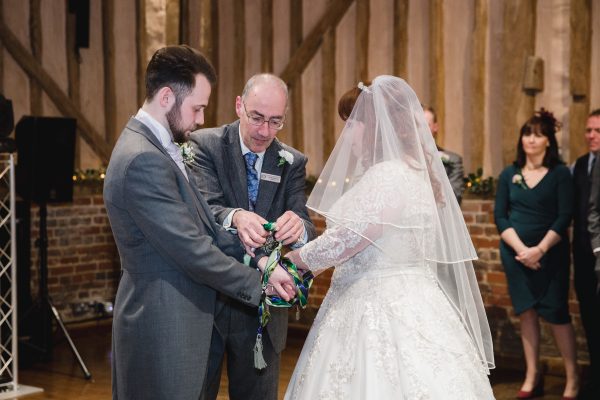
by Michael | Jan 22, 2018 | Blog
Rituals can add dramatically to the atmosphere and spirituality of a ceremony. As a civil celebrant, I am often asked for suggestions as to items that can enhance the service.
I am going to leave out religious rituals, although I do readily incorporate some, especially in mixed-faith services. For one thing, there are rather a lot of religions to mention, and I only have a few hundred words at my disposal!
There is a whole range of rituals that may appeal, so, although I’m only covering a few here, please be aware that the list is by no means exhaustive.
Moreover, there are variants to most of the rituals, so there may not be a ‘right or wrong’ way of doing them.
Handfasting
Probably my most requested ritual is handfasting. You may not know that the expression “tying the knot” is derived from this. The couple take each other’s hands, left to left and right to right. To the accompaniment of suitable words, the celebrant knots the couple’s chosen ribbons or cords (often in an infinity sign).
The couple are soon released, but take home the knotted ribbon as a reminder of what they promised each other on the day.
A handfasting can be part of a full pagan ceremony, but it may just be a brief – but beautiful and meaningful – section of the service.
Unity Rituals
The Loving Cup (or “Quaich”) is another popular inclusion. Very simply, it is a goblet (usually with some wine in – not too much!) which bride and groom both drink from, one handing the goblet to the other in turn. It symbolises unity, of course.
An alternative is a sand ceremony. This is where two (or more, to include extended family/friends) phials of sand of different colours are together poured into a bigger vial.
Similarly, you can have a Unity Candle, and two (or more) people light it with tapers.
All these actions are accompanied by appropriate words by the celebrant.
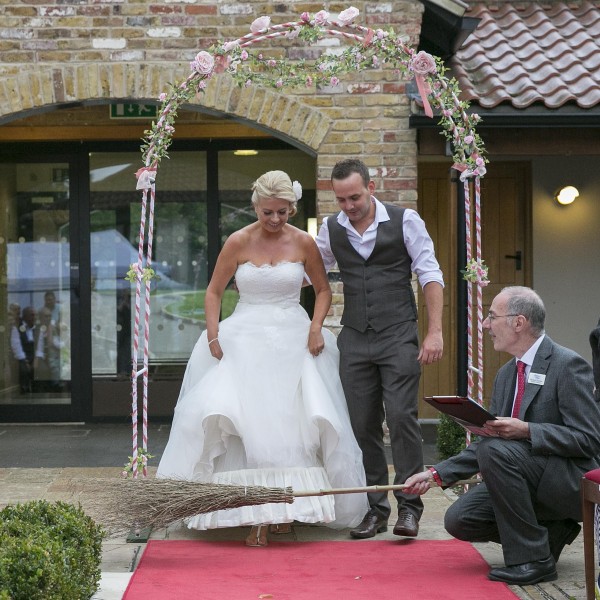
Jumping the Broom
There are various origins to this ceremony, but it involves the couple jumping over a besom (a sort of witch’s broom). The new home symbolism (sweeping out the old) is fairly evident, but it can have the extra element of introducing a bit of humour to the proceedings.
So these add-ons, or others like them, can make a real difference to the atmosphere of the ceremony.
Naturally, if you want to explore this any further, do feel free to let me know.
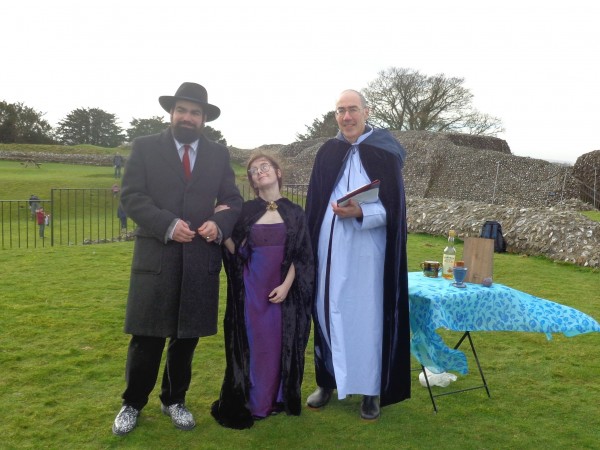
by Michael | Nov 30, 2015 | Blog
People regularly ask me “what’s a handfasting?”
I think my favourite one was at Old Sarum in 2014, and describing the events may give a flavour of the ceremony and thus answer the question.
The Setting
The setting was spectacular. We were allocated a lovely rectangular grassy spot in the Castle ruins, overlooking, as well as a flooded plain, the ruins of the old cathedral.
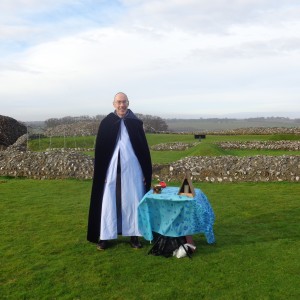
Having an outdoor ceremony the last weekend of January on an exposed hilltop with the winter we’d been having might be said to be tempting providence. I had to drive through heavy rain for a couple of hours the evening before to get to Wiltshire, so I feared the worst. Then my arrival home after the ceremony coincided with thunder, lightning and hailstones! So what about the intervening spell?
The Weather
Miraculously, it was dry – in fact, the sun came out for quite a time – and unseasonably warm. I did eventually get cold, as I was up there early, to set up the space, and the wedding party arrived half an hour late, but to spend two hours, as I did, up there without ill effects from the weather was quite remarkable. I did have a close encounter with a hawk (wondering if it was a vulture, preparing to feast on my frozen body!).
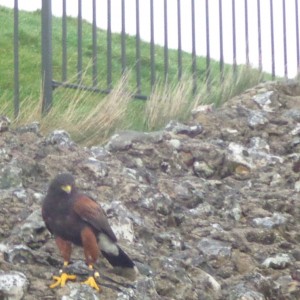
The Ceremony
The ceremony was part-pagan, part-Jewish, which is original, if nothing else! The rituals included representatives of the four elements blessing the couple, the handfasting itself, the bride walking round the groom seven times and the breaking of a glass underfoot.
The handfasting
In a little more detail regarding the actual handfasting, we started by charging the circle. Then we summoned the elements of nature, with representatives of the four directions blessing the couple. We then called upon the God and Goddess, to connect the couple with the divinity within themselves. We next blessed the couple with divine qualities.
Taking symbolic (empty) cups and exchanging them, the couple repeated this Celtic handfasting vow together:
“You cannot possess me, for I belong to myself.
But while we both wish it, I give you that which is mine to give.
You cannot command me, for I am a free person.
I pledge to you that it will be your eyes into which I smile every morning.
I pledge to you my living and my dying, each equally in your care.
I shall be a shield for your back, and you for mine.
I shall not slander you, nor you me.
I shall honour you above all others, and when we quarrel, we shall do so in private and tell no strangers our grievances.
This is my wedding vow to you.
This is the marriage of equals.”
Rather beautiful, wouldn’t you agree?
After the exchange of vows, we witnessed the handfasting(or binding of wrists) itself, followed by drinking from (what was not an empty!) loving cup, before a concluding blessing.
I’m delighted to say that it was a very special ceremony for all concerned – and I’m looking forward to my next one.





